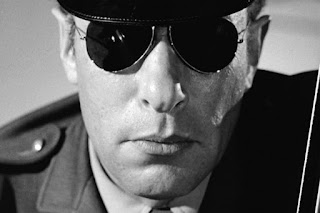Alfred
Hitchcock’s Psycho (1960), a classic
film that changed the horror genre for future generations and created the
slasher genre. While people may be aware of the shower scene which caused
controversy during it`s time, people forget the toilet flush scene which seemed
to cause more uproar than the actual murder. Why? Maybe to create discomfort in
the audience before the murder begins, to help the grimness of the murder sink
in. Maybe also to make the audience feel discomfort and filthy by watching the
scene and following the murder maybe this technique is used to make the
audience feel partly as if they are part of the murder.
Continuing
with the ingenious of Hitchcock’s use of camera and lighting, the atmosphere is
compelling in this film where the audience can feel what the characters in the
film are feeling. An example of this is where when Marion is escaping and gets
interrogated by the police man. Immediately the audience is faced with this
darkened face taking up the entire camera giving a
sense of threat and no
escape. Especially the added detail of glasses, there is no emotion seen which
the policeman seem almost beast like due to the lack of anything shown on his
face. Another example of this is when Sam is interrogating Norman. The camera
drops to where we can only see Normans throat and Adams apple as his
nervousness is shown through his speech. Not only that the only detail we can
see if Normans quivering Adams apple emphasising the guilt and fear he feels.
The audience doesn’t need to see his face due to the lack of emotion or masked
emotion he showed before Marion was murdered.
 |
| Fig 2 : Profile |
When
it comes to the reveal, although comical with Norman running into the scene and
his wig falling off, the idea of multiple personality disorder begins to tie
the film together as to why the audience doesn’t ever see the face of the
killer nor the audience never sees the mother. When looking over the scene, the
use of mental health being used as an excuse for murder makes the views of
mental health back then clear. How mental health was seen as something not
right in the brain and if you had mental health troubles you were crazy.
“Hitchcock deliberately wanted
"Psycho" to look like a cheap exploitation film. He shot it not with
his usual expensive feature crew (which had just finished "North by
Northwest") but with the crew he used for his television show.” (Ebert,
1998) While Hitchcock is considered a god with camera, his reasoning behind
using a
restricted set may be to make the film seem more authentic and home
recorded making the events what happen
seem all the more real. Also the less people there and low budget make the set
seem less perfect and worn down. Especially with the idea of a haunted house
the setting isn`t going to be a perfect structure.
Having
such a big influence on the audience, Hitchcock ensures that every detail is
set so the audience feels as if they are in the film and makes each scene as believable
as possible. “Many viewers still insist
that the blood running down the plughole after Marion's murder is
bright red,
but it is the power of their imaginations that makes the brown chocolate syrup
seem so.” (Kermode , 2010) .Despite the clear time difference between then
and now, the audience cannot help but feel the same atmosphere as people did
back then. Where the audience are teased by technical detail to enhance the
atmosphere and strengthen the need to know who the killer is. Just as Hitchcock
intends. “The audience is similarly helpless in Hitchcock's "trap" –
but you wouldn't have it any other way.” (Monahan, 2015)
 |
| Fig 3 : Blood |
Bibliography :
Kermode,M(2010) Psycho : the best horror film of all time http://www.theguardian.com/film/2010/oct/22/psycho-horror-hitchcock [Accessed 24/01/16] Monahan,M(2015) Psycho,review : http://www.telegraph.co.uk/culture/film/filmreviews/11025424/Psycho-review.html [Accessed 24/01/16] Ebert , R (1998) Great Movie : Psycho : http://www.rogerebert.com/reviews/great-movie-psycho-1960 [Accessed 24/01/16]
Illustrations :
Fig 1 Psycho_1960 [Poster] https://en.wikipedia.org/wiki/File:Psycho_%281960%29.jpg [Accessed 24/01/16]
Fig 2 Profile [Screengrab] http://www.thedoublenegative.co.uk/2015/03/in-profile-alfred-hitchcocks-psycho-1960/ [Accessed 24/01/16]
Fig 3 Blood [Screengrab] https://niels85.wordpress.com/2013/06/12/the-alfred-hitchcock-marathon-part-5-psycho-1960/ [Accessed 24/01/16]


Interesting review Sarah - good discussion around the techniques used to get the audience immersed in the action.
ReplyDeleteJust check your bibliography - poor Roger Ebert has got tangled in with Mark Kermode's review :)